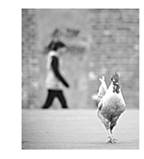Tiredness, coughing, a runny nose and a sore throat—among all sicknesses there is probably none more common than the flu, which we all get now and then.

However, bird flu is a completely different story.
Ten years ago, the H5N1 bird flu swept across 15 countries, including China, with sufferers reporting chest pain, difficulty breathing, fever and severe coughing. More than 600 people were infected, and about 60 percent died. Now another type of bird flu hit Shanghai and three neighboring provinces, and this time the virus is called H7N9. By the afternoon of April 11, the new virus had taken nine lives out of 35 infected, according to Xinhua News Agency.
The“H”and“N”in the virus’ name refers to two kinds of proteins on the surface of the virus. Any change of the numbers of the two proteins indicates a new mutation(变异). Most of the mutations only affect birds, such as chickens and pigeons, and don’t normally spread to humans. But once they do, the results can be disastrous.
“Any time an animal influenza virus crosses to humans, it is a cause for concern, ”Malik Peiris, virologist(病毒学家)at the University of Hong Kong, told Nature magazine. Take the SARS epidemic(传染病)10 years ago as an example. The virus behind the disease is thought to have jumped to humans from animals. The virus was a complete“stranger”to human bodies, which hadn’t developed an immunity against it.
But there is something more about the new H7N9 bird flu. Unlike the H5N1 bird flu, which causes severe sickness in birds, the H7N9 has been evolving under the radar(悄悄地)since it travels between birds without causing noticeable illness. That makes it difficult to keep track of the disease.
The good news is that there’s so far no sign that the virus is spreading from person to person. But since there is no vaccine for the disease yet, the World Health Organization recommends that you wash your hands after meeting with sick people and before and after you eat or prepare food, and they also suggest avoiding contact with birds or their eggs.
小题1:Which of the following statements is TRUE according to the text?
| A.The H5N1 bird flu turned out to have something to do with the SARS epidemic. |
| B.More than 600 people across the world died from the H5N1 bird flu ten years ago. |
| C.Most of the mutations of the proteins in the bird flu virus are harmful to both birds and humans. |
| D.The name, H7N9 bird flu, shows that there have been new mutations of the proteins in the virus. |
小题2:With the example of the SARS epidemic in Paragraph 5, the author intends to
.
| A.introduce where the SARS virus came from |
| B.inform us of the harmful effects of the SARS epidemic ten years ago |
| C.show the horrible effects an animal influenza virus can have once it spreads to humans |
| D.compare the differences between the SARS epidemic and the H7N9 bird flu |
小题3:What makes the H7N9 bird flu more frightening than the H5N1 bird flu according to the text?
| A.It can cause severe sickness in birds. |
| B.It can spread from person to person. |
| C.It affects a greater number of birds. |
| D.It doesn’t sicken birds and thus can spread unnoticed. |
小题4:What are people advised to do to protect themselves against the H7N9 bird flu?
a. To get vaccinated for the disease.
b. To keep away from birds and their eggs.
c. To stop eating chickens and ducks.
d. To avoid meeting with sick people.
e. To wash hands thoroughly and regularly.
| A.a, b | B.c, d |
| C.b, e | D.a, e |




